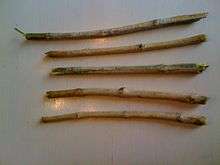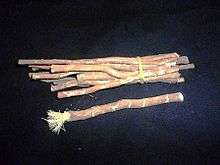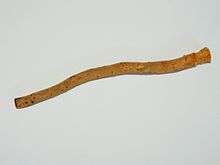Miswak
The miswak (miswaak, siwak, sewak, Arabic: سواك or مسواك) is a teeth cleaning twig made from the Salvadora persica tree (known as arāk, أراك, in Arabic). It is reputed to have been used over 7000 years ago.[1] The miswak's properties have been described thus: "Apart from their antibacterial activity which may help control the formation and activity of dental plaque, they can be used effectively as a natural toothbrush for teeth cleaning. Such sticks are effective, inexpensive, common, available, and contain many medical properties".[2] It also features prominently in Islamic hygienical jurisprudence.

| Part of a series on |
| Islamic jurisprudence (fiqh) |
|---|
 |
|
| Islamic studies |
The miswak is predominant in Muslim-inhabited areas. It is commonly used in the Arabian peninsula, the Horn of Africa, North Africa, parts of the Sahel, the Indian subcontinent, Central Asia and Southeast Asia. In Malaysia, miswak is known as Kayu Sugi (Malay for 'chewing stick').
Science
Studies
The World Health Organization (WHO) recommended the use of the miswak in 1986, but in 2000 an international consensus report on oral hygiene concluded that further research was needed to document the effect of the miswak.[3] Some of this further research has been done on a population of 203, and concluded, in turn, "that the periodontal status of miswak users in this Sudanese population is better than that of toothbrush users".[4] Yet another comparative study conducted on a sampling of 480 Saudi Arabian adults found that "the level of need for periodontal care in the sample chosen is low when compared with the findings of similar studies undertaken in other countries. The frequent use of the 'Miswak' was associated with a lower need for treatment".[5]
A 2016 paper has been published comparing human DNA left on used miswak and toothbrushes, including the effect of time, to determine whether miswak is a reasonable source of DNA when found at crime scenes. The conclusion was that miswak contains a high enough quantity of DNA, and retained good DNA profiling; and when compared to toothbrushes, miswak is a reasonable source of DNA for forensic profiling. In addition, time of storage up to 4 months had no or little effects on results.[6]
Miswak extract vs. oral disinfectants
Studies indicate that Salvadora persica extract exhibits low antimicrobial activity compared to other oral disinfectants and anti-plaque agents like triclosan and chlorhexidine gluconate.[7]
Mouthrinses containing chlorhexidine was with maximum antibacterial activity, while cetylpyridinium chloride mouthrinses were with moderate and miswak extract was with low antibacterial activity.[7]
However, the benefits of triclosan were discounted by the United States Food and Drug Administration in 2016 and its safety is uncertain as a hygiene product ingredient.[8] Chlorhexidine gluconate was also linked to serious allergic reactions, albeit rarely.[9]
Religious prescriptions

The use of the miswak is frequently advocated in the hadith (the traditions relating to the life of Muhammad). Situations where the miswak is recommended to be used include before religious practice, before entering one's house, before and after going on a journey, on Fridays,[10] before sleeping and after waking up, when experiencing hunger or thirst and before entering any good gathering.
In addition to strengthening the gums, preventing tooth decay and eliminating toothaches, the miswak is said to halt further decay that has already set in. Furthermore, it is reputed to create a fragrance in the mouth, eliminate bad breath, improve sensitivity of taste-buds and promote cleaner teeth.
A hadith concerning the miswak
It is often mentioned that the Islamic prophet Muhammad recommended the miswak's use.[11] He is quoted in various hadith extolling its virtues:[12][13]
Were it not that I might over-burden the Believers I would have ordered them to use Siwak (Miswak) at the time of every Prayer.[14]
Four things are from among the practices of the Prophets: Circumcision, Perfume, Miswak, and Marriage.[14]
Make a regular practice of Miswak for verily it is the purification for the mouth and a means of the pleasure of the Lord.[14]
Use the Miswaak, for verily, it purifies the mouth, and it is a Pleasure for the Lord. Jib-ra-eel (A.S.) exhorted me so much to use the Miswaak that I feared that its use would be decreed obligatory upon me and upon my Ummah. If I did not fear imposing hardship on my Ummah I would have made its use obligatory upon my people. Verily, I use the Miswaak so much that I fear the front part of my mouth being peeled (by constant and abundant brushing with the Miswaak)[15]
Maintenance

A miswak should be one hand span in length when selected. If it becomes dry, it should be soaked in any water to soften the end bristles. The end should be cut afresh to ensure hygiene and should never be stored near a toilet or sink. The brush may be created by cutting Salvadora persica's branches instead of its roots; keeping in mind that the tree's roots can retain moisture more so than its branches. This favors more long-term usage.
Carrying
Many companies offer special cases for carrying miswak. Many of these companies also produce miswak itself. The main purpose of these cases is to protect and carry miswak in order to preserve its freshness. Plastic toothbrush cases are available at most drug stores and may be used for carrying a Miswak.
References
- Ra'ed I. Al Sadhan, Khalid Almas (1999). "Miswak (chewing Stick): A Cultural And Scientific Heritage". Saudi Dental Journal. 11 (2): 80–88.
- Al lafi T, Ababneh H (1995). "The effect of the extract of the miswak (chewing sticks) used in Jordan and the Middle East on oral bacteria". International Dental Journal. 45 (3): 218–222. PMID 7558361.
- "Darout, Ismail Abbas, Undersøkelse av en aktuell eldgammel munnrengjøringsmetode, dr.odont., disputas: 23.06.2003". www.uib.no (in Norwegian). Archived from the original on 2011-06-05. Retrieved 2006-04-11.
- Darout, Ismail A.; Albandar, Jasim M.; Skaug, Nils (January 2000). "Periodontal status of adult Sudanese habitual users of miswak chewing sticks or toothbrushes". Acta Odontologica Scandinavica. 58 (1): 25–30. doi:10.1080/000163500429398. PMID 10809396.
- al-Khateeb TL, O'Mullane DM, Whelton H, Sulaiman MI (2003). "Periodontal treatment needs among Saudi Arabian adults and their relationship to the use of the Miswak". Community Dental Health. 8 (4): 323–328. ISSN 0265-539X. PMID 1790476.
- Alfadaly, N., Kassab, A., & Al Hedaithy, F. (2016). Determination of DNA profiling of siwak and toothbrush samples used in Kingdom of Saudi Arabia. Egyptian Journal of Medical Human Genetics, 17(4), 383-387.
- Almas, K; Skaug, N; Ahmad, I. (February 2005). "An in vitro antimicrobial comparison of miswak extract with commercially available non-alcohol mouthrinses". Int J Dent Hyg. 3 (1): 18–24. doi:10.1111/j.1601-5037.2004.00111.x. PMID 16451373.
- Commissioner, Office of the. "Consumer Updates - 5 Things to Know About Triclosan". www.fda.gov. Retrieved 2017-09-23.
- Commissioner, Office of the. "Safety Alerts for Human Medical Products - Chlorhexidine Gluconate: Drug Safety Communication - Rare But Serious Allergic Reactions". www.fda.gov. Retrieved 2017-09-23.
- "الرئيسة - الحديث - موقع الإسلام". hadith.al-islam.com.
- "Excellence of Miswak in Hadiths" at ziaetaiba.com.
- "Miswak" at sunnah.com.
- "Siwak" at searchtruth.com.
- IslamKotob, Muslims and "Science", (Islamic Books), p.30.
- Farouk, Muhammed. "Miswak/Sewak". www.islam.tc. Archived from the original on 2010-12-22. Retrieved 2006-02-15.
Further reading
- Islamic Research on Miswak (Dr. Al Sahli)
- Khan, Tehmeena, Toothbrush (Miswak), in Muhammad in History, Thought, and Culture: An Encyclopedia of the Prophet of God (2 vols.), Edited by C. Fitzpatrick and A. Walker, Santa Barbara, ABC-CLIO, 2014.
External links
| Wikimedia Commons has media related to Miswak. |